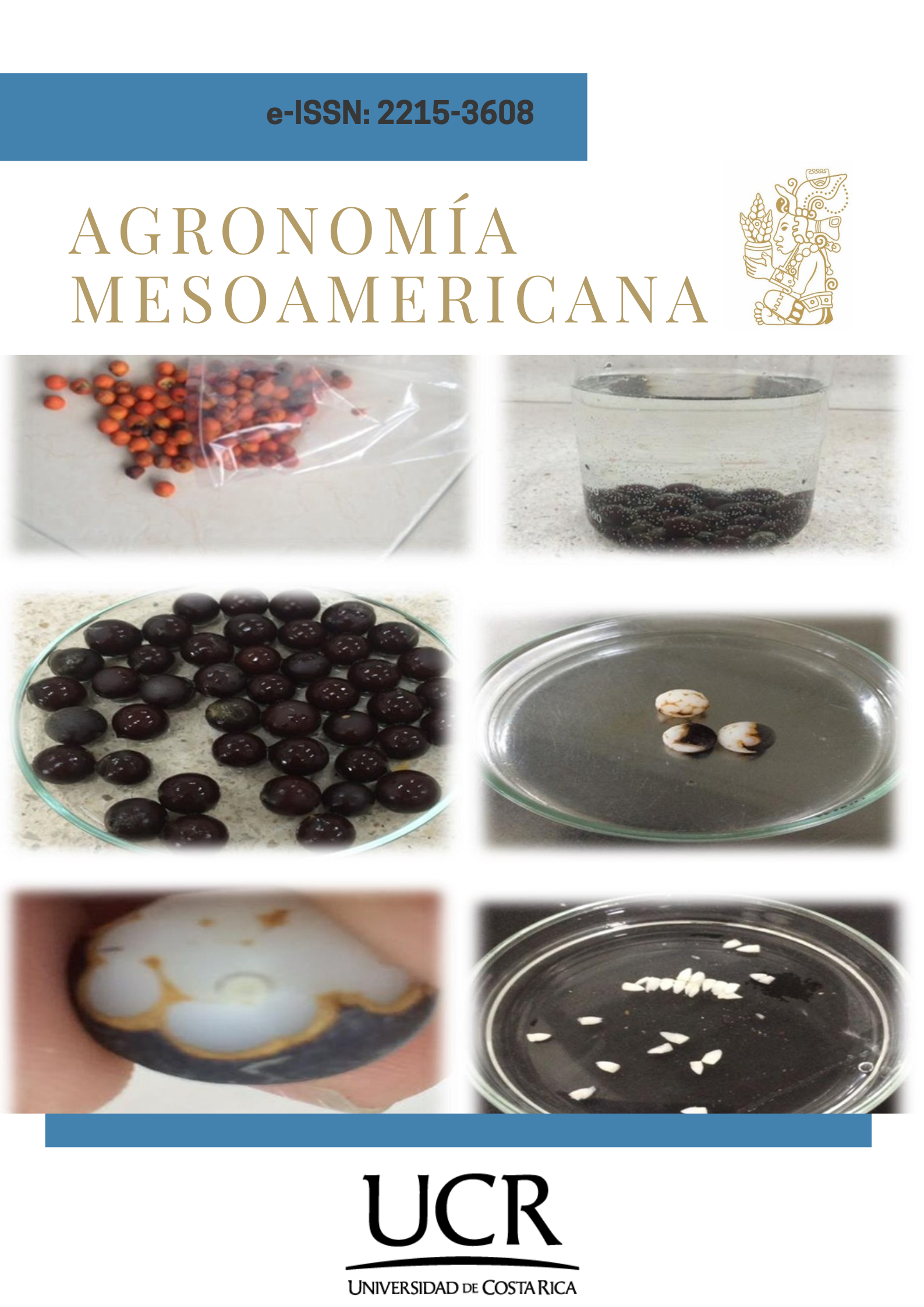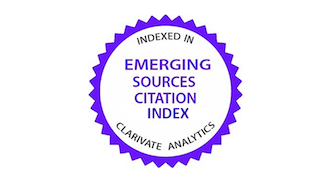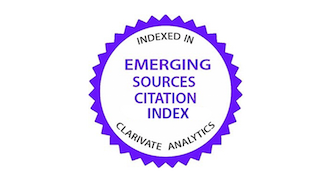Disinfection of zygotic embryos of Ceroxylon alpinum Bonpl. for in vitro establishment
DOI:
https://doi.org/10.15517/am.2025.61825Keywords:
explants, sterilization, sodium hypochlorite, safety, wax palmAbstract
Introduction. The genus Ceroxylon comprises vulnerable Andean palm species threatened by human
intervention. Ceroxylon alpinum Bonpl. seeds specifically exhibit low germination rates, slow growth, and require
complex environmental interactions for development. Objective. To evaluate disinfection methods for zygotic palm embryos to facilitate in vitro cultivation and micropropagation. Materials and methods. Research was conducted
between February 2021 and March 2022. Wax palm (Ceroxylon alpinum Bonpl.) seeds were harvested during the fruiting stage in El Cairo forest, Salento, Quindío, Colombia, selecting specimens with optimal morphological development and phytosanitary conditions. Seeds were transferred to the Plant Biotechnology Laboratory-CIBUQ in Armenia, Quindío. Surface sterilization was performed using neutral detergent Tween 20 at a concentration of 0.1 % (v/v) and running water, followed by immersion in 3 % NaClO for 25 minutes. Embryos were extracted under a stereoscope and immersed in 70 % alcohol for one minute. Subsequently, they underwent different NaClO concentration treatments for 10 minutes before being cultivated in Murashige & Skoog (MS) medium and evaluated for eight weeks. A completely randomized design with a single factor (NaClO concentration) and three levels (1 %, 1.5 %, and 2 %) was used, analyzed through analysis of variance and Tukey’s test (α = 0.05) using Statistica 8 software. Results. Disinfection with 1.5 % NaClO (T2) demonstrated optimal efficacy, yielding 75 % survival and 74 % embryo sprouting rates. In contrast, 2 % NaClO concentration resulted in increased contamination. Conclusion. The disinfection method using 1.5 % NaClO proved most effective for enabling the viability of wax palm zygotic embryos, maximizing in vitro survival and sprouting, thereby enhancing prospects for micropropagation and conservation of this endangered species.
Downloads
References
Anwar, M., Chen, L., Xiao, Y., Wu, J., Zeng, L., Li, H., Wu, Q., & Hu, Z. (2021). Recent advanced metabolic and genetic engineering of phenylpropanoid biosynthetic pathways. International Journal of Molecular Sciences, 22(17), Article 9544. https://doi.org/10.3390/ijms22179544 DOI: https://doi.org/10.3390/ijms22179544
Bacon, C. D., Roncal, J., Andermann, T., Barnes, C. J., Balslev, H., Gutiérrez-Pinto, N., Morales, H., Núñez-Avelleneda, L. A., Tunarosa, N., & Antonelli, A. (2021). Genomic and niche divergence in an Amazonian palm species complex. Botanical Journal of the Linnean Society, 197(4), 498–512. https://doi.org/10.1093/botlinnean/boab012 DOI: https://doi.org/10.1093/botlinnean/boab012
Benchimol, M., Talora, D. C., Mariano-Neto, E., Oliveira, T. L. S., Leal, A., Mielke, M. S., & Faria, D. (2017). Losing our palms: the influence of landscape-scale deforestation on Arecaceae diversity in the Atlantic Forest. Forest Ecology and Management, 384, 314–322. https://doi.org/10.1016/j.foreco.2016.11.014 DOI: https://doi.org/10.1016/j.foreco.2016.11.014
Brodsky, A., Abakumov, E., & Kirillova, I. (2023). Problems in threatened species conservation: Differences in national red lists assessments with global standards. Diversity, 15(3), Article 337. https://doi.org/10.3390/d15030337 DOI: https://doi.org/10.3390/d15030337
Chacón-Vargas, K., García-Merchán, V. H., & Sanín, M. J. (2020). From keystone species to conservation: conservation genetics of wax palm Ceroxylon quindiuense in the largest wild populations of Colombia and selected neighboring ex situ plant collections. Biodiversity and Conservation, 29, 283–302. https://doi.org/10.1007/s10531-019-01882-w DOI: https://doi.org/10.1007/s10531-019-01882-w
Corozo, L., Héctor, E., Macías, F., Vásquez, B., Pinargote, B., Cobeña, G., Mendoza, A., & Arteaga, F. (2020). Micropropagación de dos variedades ecuatorianas de yuca (Manihot esculenta Crantz). Chilean Journal of Agricultural & Animal Sciences, 36(3), 224–232. https://revistas.udec.cl/index.php/chjaas/article/view/2985/3069 DOI: https://doi.org/10.29393/CHJAAS36-21MDLC80022
Corporación Autónoma Regional de Cundinamarca. (2018). Plan de manejo y conservación de la palma real (Ceroxylon alpinum Bonpl. Ex DC.) en la jurisdicción CAR Cundinamarca. https://www.car.gov.co/uploads/files/60d37ec3b6da0.pdf
Couvreur, T. L. P., Jijon, N., Montúfar, R., Morales-Morales, P. A., Sanín, M. J., Copete, J. C., Lozinguez, A., Pérez, Á. J., & Beech, E. (2024). Diversity and conservation status of palms (Arecaceae) in two hotspots of biodiversity in Colombia and Ecuador. Plants, People, Planet, 6(4), 885–901. https://doi.org/10.1002/ppp3.10506 DOI: https://doi.org/10.1002/ppp3.10506
Custódio, L., Charles, G., Magné, C., Barba-Espín, G., Piqueras, A., Hernández, J. A., Ben Hamed, K., Castañeda-Loaiza, V., Fernandes, E., & Rodrigues, M. J. (2023). Application of In Vitro Plant Tissue Culture Techniques to Halophyte Species: A Review. Plants, 12(1), Article 126. https://doi.org/10.3390/plants12010126 DOI: https://doi.org/10.3390/plants12010126
Espinosa-Leal, C. A., Puente-Garza, C. A., & García-Lara, S. (2018). Cultivo de tejidos vegetales in vitro: Medios para la producción de compuestos biológicos activos. Planta, 248, 1–18. https://doi.org/10.1007/s00425-018-2910-1 DOI: https://doi.org/10.1007/s00425-018-2910-1
Faria, R. T., & Illg, R. D. (2025). Micropropagación de Zingiber spectabile griff. Scientia Horticulturae, 62(1–2), 135–137. https://doi.org/10.1016/0304-4238(94)00759-9 DOI: https://doi.org/10.1016/0304-4238(94)00759-9
Fernández-Hilario, R., Pillaca-Huacre, L., Villanueva-Espinoza, R., Riva-Regalado, S., Rojas González, R. del P., Goldenberg, R., & Michelangeli, F. A. (2024). Taxonomic and chorological novelties in Blakea (Melastomataceae: Pyxidantheae) from Peru with a list of species for the country. Phytotaxa, 635(1), 1-42. https://doi.org/10.11646/phytotaxa.635.1.1 DOI: https://doi.org/10.11646/phytotaxa.635.1.1
Galeano, G., Bernal, R., & Sanín, M. J. (2015). Plan de conservación, manejo y uso sostenible de la palma de cera del Quindío (Ceroxylon quindiuense), Árbol Nacional de Colombia. Ministerio de Ambiente y Desarrollo Sostenible & Universidad Nacional de Colombia. https://archivo.minambiente.gov.co/images/BosquesBiodiversidadyServiciosEcosistemicos/pdf/Programas-para-la-gestion-de-fauna-y-flora/Plan_de_conservaci%C3%B3n_manejo_y_uso_sostenible_de_la_palma_de_cera_del_Quind%C3%ADo.pdf
Gammoudi, N., Nagaz, K., & Ferchichi, A. (2022). Establishment of optimized in vitro disinfection protocol of Pistacia vera L. explants mediated a computational approach: multilayer perceptron-multi-objective genetic algorithm. BMC Plant Biology, 22(1), Article 324. https://doi.org/10.1186/s12870-022-03674-x DOI: https://doi.org/10.1186/s12870-022-03674-x
González-Rivillas, N., Bohórquez, A., Gutiérrez, J. P., & García-Merchán, V. H. (2018). Diversity and population genetic structure of the wax palm Ceroxylon quindiuense in the Colombian Coffee region. bioRxiv, 2018, Article 443960. https://doi.org/10.1101/443960 DOI: https://doi.org/10.1101/443960
Guerra, M. P., & Dal Vesco, L. L. (2010). Estrategias para la micropropagación de bromelias. En S. M. Jain, & S. J. Ochatt (Eds.), Protocolos para la propagación in vitro de plantas ornamentales (pp. 47–66). Humana Press-Springer. https://doi.org/10.1007/978-1-60761-723-5_4 DOI: https://doi.org/10.1007/978-1-60761-723-5_4
Henderson, A. (2024). Pollination systems of palms (Arecaceae). Journal of Pollination Ecology, 36, 144–248. https://doi.org/10.26786/1920-7603(2024)782 DOI: https://doi.org/10.26786/1920-7603(2024)782
Instituto de Investigación de Recursos Biológicos Alexander von Humboldt. (2017). Estado actual de conservación de la población de Ceroxylon quindiuense (H.Karst.) H. Wendl. (Arecaceae) en la microcuenca del río Tochecito, Tolima. http://i2d.humboldt.org.co/ceiba/resource.do?r=rrbb_palma_tochecito_2017
Jatoi, M. A., Abul-Soad, A. A., Markhand, G. S., & Solangi, N. (2015). Establishment of an efficient protocol for micropropagation of some Pakistani cultivars of date palm (Phoenix dactylifera L.) using novel inflorescence explants. Pakistan Journal of Botany, 47(5), 1921–1927. https://www.pakbs.org/pjbot/PDFs/47(5)/40.pdf
Kalyana Babu, B., Mathur, R. K., Suresh, K., Ravichandran, G., Susanthi, B., Patil, G. B., Ruthweek, N., & Mahesh, M. (2025). Efficient regeneration protocol for producing true-to-type oil palm (Elaeis guineensis [jacq.]) through somatic embryogenesis from immature male inflorescence. Heliyon, 11(1), Article e41479. https://doi.org/10.1016/j.heliyon.2024.e41479 DOI: https://doi.org/10.1016/j.heliyon.2024.e41479
Khan, M. A., Hazra, M., Mahato, S., Spicer, R. A., Roy, K., Hazra, T., Bandopadhaya, M., Spicer, T. E. V., & Bera, S. (2020). A Cretaceous Gondwana origin of the wax palm subfamily (Ceroxyloideae: Arecaceae) and its paleobiogeographic context. Review of Palaeobotany and Palynology, 283, Article 104318. https://doi.org/10.1016/j.revpalbo.2020.104318 DOI: https://doi.org/10.1016/j.revpalbo.2020.104318
Kulus, D., & Tymoszuk, A. (2024). Advancements in in vitro technology: A comprehensive exploration of micropropagated plants. Horticulturae, 10(1), Article 88. https://doi.org/10.3390/horticulturae10010088 DOI: https://doi.org/10.3390/horticulturae10010088
Leelavathy, S., & Sankar, P. D. (2016). Curbing the menace of contamination in plant tissue culture. Journal of Pure and Applied Microbiology, 10(3), 2145–2152. https://microbiologyjournal.org/curbing-the-menace-of-contamination-in-plant-tissue-culture/
Martínez-Montero, M. E., Gonzalez Arnao, M. T., & Engelmann, F. (2012). Cryopreservation of tropical plant germplasm with vegetative propagation - Review of sugarcane (Saccharum spp.) and pineapple (Ananas comusus (L.) Merrill) cases. In I. I. Katkov (Ed.), Current frontiers in cryopreservation (Chapter 18, pp. 359–396). Intechopen. https://doi.org/10.5772/32047 DOI: https://doi.org/10.5772/32047
Mazri, M. A., & Meziani, R. (2013). An improved method for micropropagation and regeneration of date palm (Phoenix dactylifera L.). Journal of Plant Biochemistry and Biotechnology, 22, 176–184. https://doi.org/10.1007/s13562-012-0147-9 DOI: https://doi.org/10.1007/s13562-012-0147-9
Murashige, T., & Skoog, F. (1962). Un medio revisado para crecimiento rápido y bioensayos con cultivos de tejido de tabaco. Physiologia Plantarum, 15(3), 473–497. https://doi.org/10.1111/j.1399-3054.1962.tb08052.x DOI: https://doi.org/10.1111/j.1399-3054.1962.tb08052.x
Orlikowska, T., Nowak, K., & Reed, B. (2017). Bacteria in the plant tissue culture environment. Plant Cell, Tissue and Organ Culture, 128, 487–508. https://doi.org/10.1007/s11240-016-1144-9 DOI: https://doi.org/10.1007/s11240-016-1144-9
Pais, A. K., Da Silva, A. P., Cardoso de Souza, J., Lopes Teixeira, S., Martins Ribeiro, J., Peixoto, A. R., & Domingos da Paz, C. (2016). Sodium hypochlorite sterilization of culture medium in micropropagation of Gerbera hybrida cv. Essandre. African Journal of Biotechnology, 15(36), 1995–1998. https://doi.org/10.5897/AJB2016.15405 DOI: https://doi.org/10.5897/AJB2016.15405
Permadi, N., Nurzaman, M., Alhasnawi, A. N., Doni, F., & Julaeha, E. (2023). Managing lethal browning and microbial contamination in Musa spp. tissue culture: synthesis and perspectives. Horticulturae, 9(4), Article 453. https://doi.org/10.3390/horticulturae9040453 DOI: https://doi.org/10.3390/horticulturae9040453
Rojas-Sandino, L. D., Cruz-Cuellar, H., & Losada-Prado, S. (2023). Análisis espacial y conectividad estructural en paisajes con palma de cera (Ceroxylon quindiuense) y su relación con aves, mariposas y mamíferos en el departamento del Tolima, Colombia. Caldasia, 45(3), 518–531. https://doi.org/10.15446/caldasia.v45n3.102536 DOI: https://doi.org/10.15446/caldasia.v45n3.102536
Sanín, M. J., & Galeano, G. (2011). A revision of the Andean wax palms, Ceroxylon (Arecaceae). Phytotaxa, 34(1), 1–64. https://doi.org/10.11646/phytotaxa.34.1.1 DOI: https://doi.org/10.11646/phytotaxa.34.1.1
Şekerli, M. (2024). Season, thermotherapy and surface sterilization play important roles in microbial contamination of hazelnut in vitro cultures. Plant Cell, Tissue and Organ Culture (PCTOC), 157, Article 70. https://doi.org/10.1007/s11240-024-02799-1 DOI: https://doi.org/10.1007/s11240-024-02799-1
Sivanesan, I., Muthu, M., Gopal, J., Tasneem, S., Kim, D.-H., & Oh, J.-W. (2021). A fumigation-based surface sterilization approach for plant tissue culture. International Journal of Environmental Research and Public Health, 18(5), Article 2282. https://doi.org/10.3390/ijerph18052282 DOI: https://doi.org/10.3390/ijerph18052282
StatSoft, Inc. (2008). Statistica (Versión 8.0) [Software de computadora]. StatSoft, Inc. https://www.statsoft.com
Teixeira da Silva, J. A., Winarto, B., Dobránszki, J., Cardoso, J. C., & Zeng, S. (2016) Tissue disinfection for preparation of Dendrobium in vitro culture. Folia Horticulturae, 28(1), 57–75. https://doi.org/10.1515/fhort-2016-0008 DOI: https://doi.org/10.1515/fhort-2016-0008
Wang, X., Morin, X., Zhang, J., Chen, G., Mao, L., Chen, Y., Song, Z., Du, Y., & Ma, K. (2023). Patrones geográficos y determinantes de la duración de la fenología reproductiva de las plantas. Frontiers in Plant Science, 14, Artículo 1199316. https://doi.org/10.3389/fpls.2023.1199316 DOI: https://doi.org/10.3389/fpls.2023.1199316

Additional Files
Published
License

This work is licensed under a Creative Commons Attribution-NonCommercial-NoDerivatives 4.0 International License.
1. Proposed policy for open access journals
Authors who publish in this journal accept the following conditions:
a. Authors retain the copyright and assign to the journal the right to the first publication, with the work registered under the attribution, non-commercial and no-derivative license from Creative Commons, which allows third parties to use what has been published as long as they mention the authorship of the work and upon first publication in this journal, the work may not be used for commercial purposes and the publications may not be used to remix, transform or create another work.
b. Authors may enter into additional independent contractual arrangements for the non-exclusive distribution of the version of the article published in this journal (e.g., including it in an institutional repository or publishing it in a book) provided that they clearly indicate that the work was first published in this journal.
c. Authors are permitted and encouraged to publish their work on the Internet (e.g. on institutional or personal pages) before and during the review and publication process, as it may lead to productive exchanges and faster and wider dissemination of published work (see The Effect of Open Access).






























